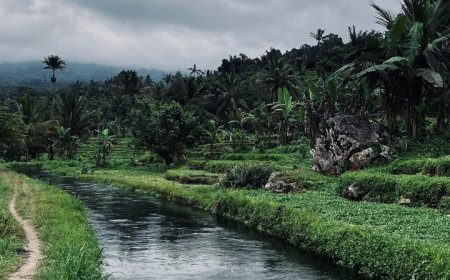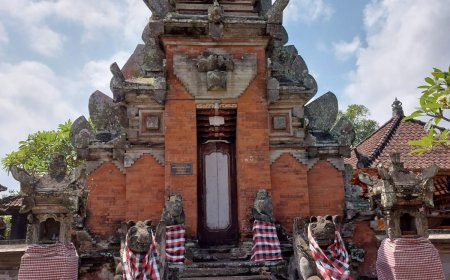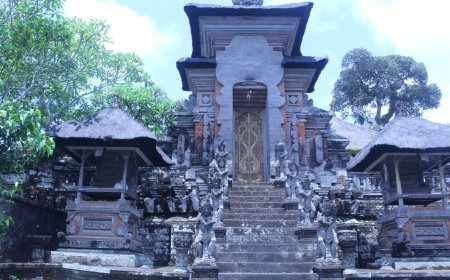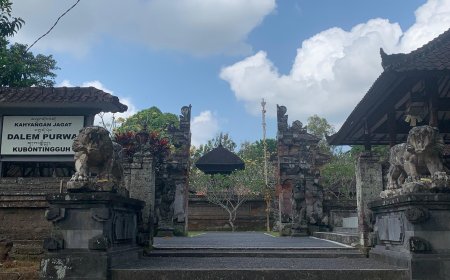Pura Luhur Natar Sari the Location of "Paruman Barong" Ritual
Pura Luhur Natar Sari, located in Tabanan Regency, Bali, is a temple that embodies the concept of Tri Mandala in Hinduism. This complex consists of three main parts, each representing the three realms in Hindu beliefs. What's fascinating is that Pura Luhur Natar Sari holds a Piodalan Ageng ceremony every 210 days, involving dozens of Barong from all over Bali, known for the Paruman Barong ritual. This ritual creates social bonds and cultural harmony, demonstrating tolerance within its tradition. The temple serves as an example of strong cultural harmony and diversity in Bali.

Pura Luhur Natar Sari is a temple located in Tabanan Regency, Baturiti District, specifically in the village of Apuan. Pura Luhur Natar Sari is managed by five customary villages, namely Apuan Village, Jelantik Village, Tua Village, Bunutin Village, and Pinge Village.
Like most temples, Pura Luhur Natar Sari consists of three sections known as the Tri Mandala, which symbolizes the Tri Loka, the three realms believed by Hindus. The outermost section represents the Nista Mandala, symbolizing Bhur Loka. In the Nista Mandala area of Pura Luhur Natar Sari, there is a Wantilan Desa, which is typically used for meetings and also serves as a place for performances and entertainment. In addition to the Wantilan, there are nine statues representing Dewata Nawa Sanga, the deities governing the cardinal directions in Hinduism. These nine statues representing Dewata Nawa Sanga in Pura Luhur Natar Sari are symbolized by characters from wayang stories, such as Anoman representing Dewa Iswara (the deity of the east), Anggada representing Dewa Maheswara (the deity of the southeast), Singajnana representing Dewa Brahma (the deity of the south), Sugriwa representing Dewa Rudra (the deity of the southwest), Sangut representing Dewa Mahadewa (the deity of the west), Anila representing Dewa Sangkara (the deity of the northwest), Dalem representing Dewa Wisnu (the deity of the north), Sempati representing Dewa Sambu (the deity of the northeast), and finally Rahwana representing Dewa Siwa (the deity of the center). Additionally, there is the Pura Melanting Desa Adat Apuan, a place of worship for Ista Dewata in its manifestation as Dewa Kuwera, the provider of prosperity for Hindus engaged in trade, with the hope that Sang Hyang Widhi Wasa (God Almighty) will provide guidance and blessings for their success and well-being, thus elevating their standard of living.
Moving into the middle section known as Madya Mandala, symbolizing Bwah Loka, there is the Bale Gunung Rata, which is generally used to welcome special guests visiting Pura Luhur Natar Sari. In the center of the Madya Mandala area, there is a Bale Saka Pat, which is the place for offerings during ceremonies. Within the Madya Mandala of Pura Luhur Natar Sari, there are also two Bale Kulkul, namely Bale Kulkul desa and Bale Kulkul pura. These two Bale Kulkul serve different functions, with Bale Kulkul Pura being sounded during temple ceremonies, while Bale Kulkul Desa is used as a means of communication to signal to the community. Additionally, there is the Pelinggih Apit Lawang, believed by Hindus to safeguard the sanctity of the temple.
Entering the innermost section of Pura Luhur Natar Sari, known as Utama Mandala, symbolizing Swah Loka, is where the worship ceremonies take place. In Utama Mandala, there is the main shrine called Pelinggih Padma Pajenengan, which houses Sang Hyang Siwa Pasupati. In ancient times, figures from the Majapahit Kingdom came to Bali after receiving revelations or guidance from Sang Hyang Widi Wasa. These revelations directed them to travel to Bali and eventually led them to Pura Luhur Natar Sari. One notable figure from the Majapahit Kingdom, named Ida Ratu Wayan Sakti, engaged in meditation and received guidance that the deity enshrined in Pura Luhur Natar Sari is Sang Hyang Siwa Pasupati. In the Utama Mandala area, there are also nine statues of Dewata Nawa Sanga, similar to those in the Nista Mandala. Additionally, there is the Padma Tiga or Tri Murti shrine, a place for worshipping the three manifestations of Ida Sang Hyang Widi Wasa, responsible for creation, preservation, and dissolution, namely Dewa Brahma as the creator, Dewa Wisnu as the preserver, and Dewa Siwa as the dissolver. The Padma on the right marks the intersection to Pura Candi Mas, the Padma on the left marks the intersection to Pura Teratai Bang, and the central Padma marks the intersection to Pura Puncak Rsi.
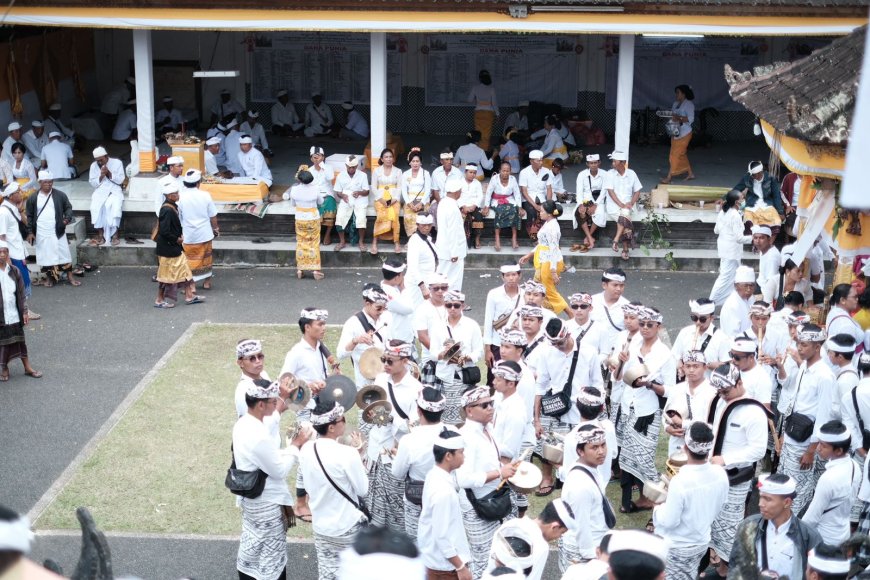
The youth from Apuan Village Megambel during Piodalan (Photo Source: Editorial Collection)
The Piodalan ceremony at Pura Luhur Natar Sari is held on Saniscara Kliwon Wuku Klurut, commonly known as Tumpek Klurut, which occurs every 210 days or every 6 months in the Balinese calendar. Following the tradition in Bali, the Piodalan Ageng is performed once a year and alternated with Piodalan Alit, where "ageng" means large and "alit" means small. During Piodalan Ageng at Pura Luhur Natar Sari, there is an intriguing ritual known as "Paruman Barong". Piodalan Ageng at Pura Luhur Natar Sari begins with the procession of pangunyan tapakan Ida Bhatara Sakti kairing, which visits various villages and temples related to it in Tabanan, Badung, and Gianyar Regencies. This procession lasts for 42 days, starting from Galungan Day to Buda Pahing Krulut, concluding with the malasti procession at Batu Bolong Beach in Canggu Village, Badung Regency. It can be said that during this procession, the villages and temples visited during the 42 days are invited to attend Piodalan Ageng at Pura Luhur Natar Sari. At the peak of the Piodalan Ageng at Pura Luhur Natar Sari, dozens of Tapakan Ratu Gede (barongs) and thousands of devotees from all over Bali attend. Notably, a day before the Piodalan Ageng begins, some devotees and barong followers stay at the homes of local residents near Pura Luhur Natar Sari. What sets Pura Luhur Natar Sari apart from other temples is that during the peak of Piodalan Ageng,Tapakan Ida Bhatara napak pertiwi (Bhatara Tedun Kabeh) are present, whereas in most other temples, they are placed in the Bale Papelik/Bale Paruman. The presence of dozens of barongs from all over Bali at Piodalan Ageng at Pura Luhur Natar Sari, with the Bhatara Tedun Kabeh procession, is what's known as the Paruman Barong ritual. Food vendors, clothing sellers, accessory shops, plant vendors, and animal vendors can also be seen around Pura Luhur Natar Sari. It's no surprise that with the multitude of devotees and barong followers coming to Pura Luhur Natar Sari, various types of vendors seize this golden opportunity to seek their fortune.
One fascinating aspect of Pura Luhur Natar Sari is the tolerance displayed in its traditions. Villages and other temples are invited to participate in religious celebrations, and the warm welcome extended to the villagers of Desa Apuan, who perform the pangunyan tapakan Ida Bhatara Sakti kairing in various villages and temples across Bali, as well as the reciprocal warm reception and provision of accommodations for visiting devotees by the residents of Desa Apuan, reflects the strong social bonds and cultural harmony forged across different communities. This temple serves as an exemplary model of how diverse communities from various villages can coexist peacefully in cultural diversity.




















